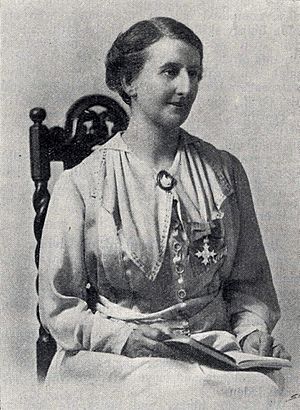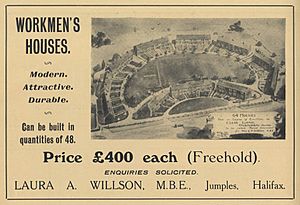Laura Annie Willson facts for kids
Quick facts for kids
Laura Annie Willson
MBE |
|
|---|---|

Laura Anne Willson c.1925
|
|
| Born |
Laura Annie Buckley
15 August 1877 Halifax, Yorkshire, England
|
| Died | 17 April 1942 (aged 64) Walton-on-Thames, Surrey, England
|
| Nationality | English |
| Occupation | Engineer, housebuilder, women's rights campaigner |
| Spouse(s) | George Henry Willson |
| Children | George William, Kathleen Vega |
| Awards | Member of the Order of the British Empire (MBE) |
Laura Annie Willson (born Laura Annie Buckley on August 15, 1877 – April 17, 1942) was an amazing English engineer and a champion for women's rights. She was known as a suffragette, which means she fought for women to have the right to vote. She was even sent to prison twice for her strong beliefs! Laura Annie Willson was also one of the people who helped start the Women's Engineering Society. Plus, she was the very first woman to join the Federation of House Builders.
Contents
Early Life and First Jobs
Laura Annie Buckley was born in Halifax, England. Her father, Charles Buckley, worked as a dyer's labourer. Her mother was Augusta Leaver.
Laura started working at a young age, just ten years old. She was a 'half-timer' in a textile factory. This meant she worked half the day and spent the other half at school. This system was put in place to make sure children got some education while also helping their families earn money.
In 1899, she married George Henry Willson. At that time, she worked as a weaver. Her husband, George, owned a successful factory that made machine tools in Halifax. Laura helped him run the business. They had two children, George, born in 1900, and Kathleen Vega, born in 1910.
Fighting for Women's Rights
Laura Annie Willson was very active in the trade union movement. Trade unions are groups that work to protect the rights of workers. In 1907, she became the secretary for the Halifax branch of the Women's Labour League. She also served as secretary for the Halifax branch of the Women's Social and Political Union, a group that strongly campaigned for women's voting rights.
In 1907, Laura took part in a strike by weavers in Hebden Bridge. She was arrested for encouraging people to cause trouble. When she went to court, she bravely pointed out that only men were on the court panel. She demanded to be judged by other women or to have a female lawyer. She was found guilty and sent to prison for fourteen days. After she was released, she famously said, "I went to gaol a rebel, but I have come out a regular terror!"
Just a few weeks later, she was arrested again with 74 other women after a rally. She was sent to Holloway Prison for another fourteen days.
In 1909, a government official named Richard Haldane was giving a speech in Halifax. The organizers tried hard to keep out anyone campaigning for women's votes. But Laura managed to get a seat near the stage. She and six other women kept interrupting his speech until they were all removed. Her husband, George, always supported her activism.
Helping During World War I
Laura and her husband were joint directors of their factory, Smith Barker & Willson. During the First World War, their factory made important supplies for the war effort, like parts for weapons. Most of the workers at the factory were women, and Laura trained and supervised them.
She noticed that some of the women workers were not eating enough so that their children could have food. To help, Laura set up a special canteen at the factory. This made sure all the women had proper meals. This great idea was then adopted by many other factories across the United Kingdom.
In 1917, Laura was given a special award called the Member of the Order of the British Empire (MBE). She received this honor for her important work helping women in the munitions factories during the war.
An Engineering Pioneer
In 1919, Laura Annie Willson helped create the Women's Engineering Society (WES). She started this group with other pioneering women like Rachel Parsons and Lady Katharine Parsons. The main goal of WES was to make sure that women who had taken on engineering jobs during World War I could keep them. It also aimed to create more opportunities for women in engineering. Laura was even the president of WES from 1926 to 1928.
Building Homes
Laura Annie Willson became the first woman to be a member of the Federation of House Builders. She used her skills to build 72 homes for workers in Halifax between 1925 and 1926.
She also helped start the Electrical Association for Women in 1924, along with Caroline Haslett. Laura was very interested in making homes modern. Her housing estates were built with the newest gas and electricity appliances. In 1927, she moved to Surrey with her husband and continued her building work by buying land there.
Laura Annie Willson's important papers and records are kept at the Surrey History Centre.
See also
 In Spanish: Laura Annie Willson para niños
In Spanish: Laura Annie Willson para niños


